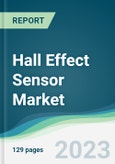The Hall effect sensor market is expected to grow at a CAGR of 6.66% from US$1.512 billion in 2021 to US$2.374 billion in 2028.
A Hall effect sensor is an electronic device designed to detect and measure magnetic fields, and it operates based on the Hall effect, which involves the creation of a voltage difference across a conductor when exposed to a perpendicular magnetic field. The sensor typically consists of a thin strip made of a semiconductor material through which current flows. Hall effect sensors can be used in industrial, automotive, and electrical & electronics sectors due to their ability to provide non-contact, accurate, and reliable detection of magnetic fields. The growth in automotive and electrical & electronics production will accelerate the demand for Hall effect sensors, stimulating the overall market growth.The surge in automotive production is boosting market growth.
Hall effect sensors are utilized in automobiles in the field of position sensing, and they are employed in applications such as throttle position sensing, pedal position sensing, gear position sensing, and steering angle sensing. These sensors provide accurate and real-time feedback on the position of various components, enabling precise control and efficient operation of critical systems. Hall effect sensors are also used in speedometers, ABS (Anti-lock Braking System), wheel speed sensors, and transmission speed sensing as these sensors detect the rotational speed of the wheels or other rotating components, allowing for precise control of vehicle speed, traction, and stability. Growing demand for fuel-efficient automobiles is driving the production. For instance, according to European Automobile Manufacturers' Association (ACEA), in 2021, 79.1 million motor vehicles were produced worldwide, an increase of 1.3% compared to 2020. According to the Society of Indian Automobile Manufacturers (SIAM), in 2022, the production of passenger vehicles increased from 3.65 million in 2021 to 4.78 million in 2022. Such growing production will simultaneously increase the demand for Hall effect sensors in the automotive sector, boosting market growth.The increasing investments in electrical & electronics production are accelerating the demand for Hall effect sensors.
The demand for accurate and reliable sensing solutions in the electrical and electronics industry continues to grow as the world becomes increasingly digitalized and interconnected. Hall effect sensors are used for current sensing and monitoring in power conversion and control circuits as they enable the precise measurement of current flow in various devices such as inverters, motor drives, power supplies, and renewable energy systems. Hall effect sensors provide a non-intrusive and highly accurate method for current sensing, ensuring efficient operation and control of these power electronic systems. Hall effect sensors find extensive use in position sensing within the electrical and electronics industry as they are employed in applications such as robotics, automation, and machinery, where accurate position feedback is critical. Growing demand for smart electronic products is driving the overall production scale in the electrical & electronics sector. According to the Directorate General of Commercial Intelligence and Statistics (DGCI&S) of India, in the fiscal year 2021-2022, the average industrial production index for electronic goods was 104.0, up 12.7%, and electronics goods exports increased from INR 81,822 crore (USD 11 billion) in 2020-2021 to INR 109,797 crore (USD 14.6 billion) in 2021-2022,The Asia Pacific region is expected to hold a significant market share during the forecast period.
The Asia-Pacific region is expected to dominate the market as the region is a hub for electronics and automotive manufacturing, with major nations such as China, India, and South Korea thriving in such sectors. In 2022, the General Office of the China State Council approved deepening institutional reform in the electrical and electronics industry. The reform would eliminate institutional obstacles to the electrical and electronics industry's high-quality development, enhance the government's ability to regulate effectively, release the vitality of market entities, and foster technical advancement. In 2020, the South Korean government announced that it would provide financial support to the country's auto industry and help speed up customs, arrange freight transportation, and provide liquidity funds for the automobile industry.Market Developments:
- June 2021: MEMSIC launched new “Ultra-Low Power Hall Switch Sensors,” which had a good consistency of magnetic open and release points (Bop/Brp) parameters and are suited for many markets, including consumer, industrial, and IoT.
- July 2020: Texas Instruments (TI) introduced the industry’s first zero-drift Hall-effect current sensors, TMCS1100, which had the highest accuracy over time and temperature and can be used in industrial motor drives, solar inverters, energy-storage equipment, and power supplies.
- June 2020: Melexis introduced an automotive-grade 3-D Hall effect sensor, MLX90395, that provides redundancy for demanding scenarios like gear level position sensing in automotive applications.
Market Segmentation:
- By Type
- Hall Switch
- Linear Hall Sensors
By End-User
- Manufacturing
- Automotive
- Electrical & Electronics
- Others
By Geography
- North America
- USA
- Canada
- Mexico
- South America
- Brazil
- Argentina
- Others
- Europe
- Germany
- UK
- France
- Spain
- Others
- Middle East and Africa
- Saudi Arabia
- UAE
- Others
- Asia Pacific
- China
- Japan
- South Korea
- India
- Australia
- Others
Table of Contents
1. INTRODUCTION
2. RESEARCH METHODOLOGY
3. EXECUTIVE SUMMARY
4. MARKET DYNAMICS
5. HALL EFFECT SENSOR MARKET BY TYPE
6. HALL EFFECT SENSOR MARKET BY END-USER
7. HALL EFFECT SENSOR MARKET BY GEOGRAPHY
8. COMPETITIVE ENVIRONMENT AND ANALYSIS
9. COMPANY PROFILES
Companies Mentioned
- Allegro MicroSystems Inc.
- Honeywell International Inc
- Infineon Technologies
- KOHSHIN ELECTRIC CORPORATION
- Littelfuse, Inc.
- MagneLink Inc.
- Sensor Solution Corp.
Methodology

LOADING...








